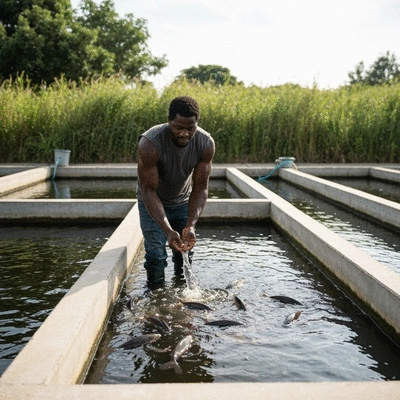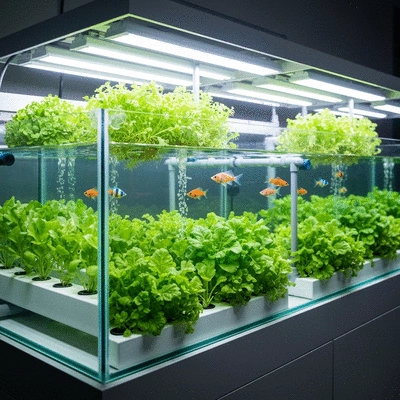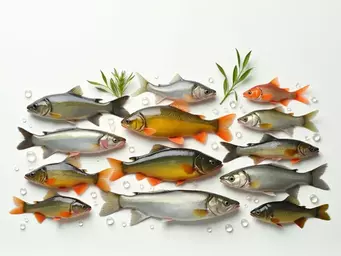Opportunities in African Fish Farming

Posted on: 2025-10-03
By: Kwame Adom
The future of aquaculture in Africa is brimming with opportunities, driven by innovation and sustainability. As we explore this vibrant market, think about how these insights could shape your approach to fish farming.
What You Will Learn
- Africa's population is set to double by 2050, increasing the demand for fish as a vital protein source.
- Urbanization is driving the need for fresh, locally sourced seafood, creating ample opportunities for fish farmers.
- Technological advancements, such as IoT and automated feeding systems, are revolutionizing aquaculture practices for better efficiency.
- Sustainable practices like aquaponics not only enhance productivity but also meet eco-conscious consumer demands.
- Market trends show that diversifying fish species and developing value-added products can significantly boost profitability.
- Engaging local communities can strengthen food security while fostering a supportive ecosystem for fish farming.
Driving Forces in African Fish Farming
The aquaculture sector in Africa is expanding rapidly, fueled by several key drivers and innovations, as well as future growth opportunities. For those looking to enter this dynamic field, understanding these forces is crucial for crafting a successful fish farming plan.
Key Growth Drivers
The primary factors accelerating the expansion of aquaculture across the continent.
- •Population Growth
- •Urbanization
- •Health Awareness
Innovations & Practices
New technologies and sustainable methods transforming traditional fish farming.
- •Automated Feeding
- •Water Quality Monitoring
- •Aquaponics Integration
Future Growth Areas
Key opportunities and trends projected to shape the industry beyond 2026.
- •Species Diversification
- •Value-Added Products
- •Global Export Markets
Understanding the African Fish Farming Market Landscape
The African fish farming market is rapidly evolving, shaped by a variety of factors that are driving growth in the aquaculture sector. As a passionate advocate for sustainable fish farming, I’ve witnessed firsthand how these dynamics create opportunities for both new and seasoned farmers. Understanding these key drivers is essential for anyone looking to thrive in this vibrant industry.
In this section, we’ll delve into the pivotal elements fueling this growth, including the increasing demand for seafood and the economic factors that influence both fish production and consumption. Let’s dive in!
Key Drivers of Growth in Aquaculture in Africa
Several vital factors are contributing to the expansion of aquaculture in Africa. Among them, a notable one is the growing demand for fish as a primary protein source. More individuals are recognizing fish as a healthy, versatile option for their diets. If you’re starting your fish farm, it's crucial to be aware of these trends!
- Population Growth: Africa's population is expected to double by 2050, leading to an increased need for food, particularly protein sources like fish.
- Urbanization: As more people move to urban areas, there's a rising demand for fresh and locally sourced seafood.
- Health Awareness: Fish is recognized for its health benefits, which is driving up its popularity among consumers.
With these factors in mind, it becomes clear why aquaculture is an appealing opportunity for entrepreneurs. Additionally, economic conditions have a significant impact on fish farming practices across the continent, making it important to understand fish market trends in Africa.

The Role of Fish Supply Increase in Meeting Seafood Demand
As the demand for seafood continues to soar, the supply of fish must keep pace. This is where the role of effective fish farming comes into play. By implementing modern aquaculture practices, farmers can significantly enhance their production levels.
For instance, farmers are increasingly adopting innovative stocking techniques and improving their feed management strategies. These advancements not only meet the rising demand but also ensure sustainability. Have you considered how optimizing your fish supply can impact your business's bottom line?
Economic Factors Influencing Fish Production and Consumption
The economic landscape in Africa presents both challenges and opportunities for fish farmers. Factors such as local market conditions, pricing, and access to finance play a crucial role in shaping the aquaculture industry.
- Market Prices: Fluctuating fish prices can affect profitability, making it essential to stay informed about local market trends.
- Investment Opportunities: Increased interest from private investors can lead to better resources and technologies for fish farming.
- Government Policies: Supportive policies can create a favorable environment for aquaculture growth, facilitating easier access to financing.
Understanding these economic drivers will enable you to strategize effectively as you build your fish farming business. Now, let’s explore how innovations in fish farming are further propelling industry growth.
The Impact of Fish Farming Innovations on Industry Growth
Innovation is at the heart of the fish farming revolution in Africa. I’ve seen many farmers successfully leverage modern technologies, which can lead to improved efficiency and sustainability in aquaculture practices. By embracing innovation, we can tackle some of the pressing challenges in the sector.
From automation in feeding to advanced breeding techniques, the landscape is changing rapidly. It’s essential to stay ahead of these trends to maximize your farm's potential!
Technological Advancements in Aquaculture Practices
Technological advancements are transforming traditional fish farming methods. For example, the use of sensors and IoT devices allows farmers to monitor water quality in real-time, ensuring optimal conditions for fish growth.
- Automated Feeding Systems: These systems help reduce feed waste and improve fish growth rates.
- Water Quality Monitoring: Real-time monitoring ensures that fish remain in a healthy environment, reducing disease outbreaks.
- Data Analytics: Utilizing big data helps farmers make informed decisions about stocking rates and feeding schedules.
Adopting these technologies can significantly enhance operational efficiency and productivity in your fish farming business. It's also vital to avoid common fish farming mistakes that can hinder progress.
Integrating Aquaponics and Sustainable Fisheries Techniques
Aquaponics is another innovative practice gaining traction among fish farmers. By integrating fish farming with plant cultivation, we can create a more sustainable ecosystem that benefits both production systems.
- Resource Efficiency: Aquaponics uses less water than traditional farming methods, making it more sustainable.
- Reduced Environmental Impact: This method minimizes waste and promotes biodiversity.
- Enhanced Profitability: Diversifying production can lead to multiple income streams for farmers.
Exploring aquaponics can open new avenues for your fish farming venture, making it not only profitable but also environmentally friendly.

Market Forecasts: Insights into the Future of Fish Farming
As we look ahead, understanding market forecasts can provide valuable insights into the future of aquaculture in Africa. I’m excited to share projections that suggest significant growth opportunities for aspiring fish farmers!
By analyzing trends and forecasts, you can make informed decisions about your business strategy and investments.
Projected Growth Trends for 2026 and Beyond
The fish farming sector is poised for remarkable growth in the coming years. Analysts predict that with the right strategies, we can witness a substantial increase in production levels and market penetration.
- Increased Demand: As mentioned earlier, the growing population will further elevate the need for fish.
- Technological Adoption: The integration of modern techniques will drive efficiency and yield.
- International Markets: There is potential for African fish products to penetrate global markets, increasing export opportunities.
These trends highlight the importance of positioning your farm for success in a competitive landscape.
Year-by-Year Analysis and Scenario Projections
To effectively navigate the future, it’s essential to conduct scenario projections and year-by-year analyses. This practice can help you anticipate changes in the industry and adapt accordingly.
- Annual Growth Rates: Understanding expected growth rates can guide your production planning.
- Market Dynamics: Analyzing shifts in consumer preferences will help you stay relevant.
- Regulatory Changes: Keeping an eye on policy changes will ensure compliance and strategic alignment.
By staying informed and proactive, you can position your fish farming business to thrive and contribute to the larger aquaculture narrative in Africa.
Regional Insights: Country-Specific Aquaculture Performance
Now that we’ve established the broader market landscape and growth drivers, let’s take a closer look at regional insights specific to various countries in Africa. Each nation has its unique challenges and opportunities, making it vital for fish farmers to understand their local markets.
Pro Tip
To maximize your fish farming success, consider implementing a blend of traditional practices with modern technologies. For instance, integrating IoT devices for real-time monitoring can significantly enhance water quality management, while utilizing local feed sources can reduce costs and support community economies. This dual approach not only improves productivity but also aligns your business with sustainable practices that resonate with today’s eco-conscious consumers.
Frequently Asked Questions About African Aquaculture
Here are some common questions about the future of fish farming in Africa:
- What are the main drivers of growth in African aquaculture?
- Population growth, rapid urbanization, and increasing health awareness are key drivers, as fish is seen as a vital protein source with numerous health benefits.
- How are technological advancements impacting fish farming in Africa?
- Innovations like automated feeding systems, real-time water quality monitoring with IoT devices, and data analytics are significantly improving efficiency, reducing waste, and preventing disease outbreaks.
- What role do sustainable practices play in the future of African aquaculture?
- Sustainable practices such as aquaponics integration are crucial for long-term success. They promote resource efficiency, reduce environmental impact, and enhance overall profitability by diversifying production.
- What are the projected growth trends for African fish farming beyond 2026?
- Analysts predict substantial growth driven by increased demand, further adoption of modern technologies, and expanding opportunities in international export markets.
- How can fish farmers engage with local communities for better success?
- Engaging with local communities through local sourcing of inputs, awareness campaigns about aquaculture benefits, and partnerships with local organizations can foster strong relationships, ensure food security, and support local economies.
Summarizing the Opportunities and Future Outlook for African Aquaculture
As we look toward the future of aquaculture in Africa, it’s crucial to reflect on the significant opportunities that lie ahead. The fish farming sector is poised for remarkable growth, driven by increased demand for seafood and innovations in farming practices. Let’s dive into some of the key takeaways from our market forecasts and the trends that could shape the industry in the coming years!
Key Takeaways from Market Forecasts and Trends
Understanding where the fish farming market is heading is vital for anyone involved in the industry. Here are some potential growth areas that I believe have exciting prospects:
- Expansion of Fish Species: Diversifying the types of fish raised, such as tilapia, catfish, and trout, can meet varying consumer preferences.
- Technological Integration: Embracing innovative technologies like IoT in monitoring aquaculture systems can enhance productivity and efficiency.
- Sustainable Practices: Increasing focus on sustainability will not only help meet regulatory requirements but also attract eco-conscious consumers.
Investors and stakeholders should monitor these trends closely, as they could open doors to new business models that align with consumer demands. I encourage you to explore how these areas can enhance your operations and profitability.
Potential Growth Areas in the Fish Farming Sector
Here’s a closer look at specific growth areas to consider:
- Aquaponics Systems: Combining fish farming with plant cultivation can create a synergistic system that maximizes resource use.
- Value-Added Products: Processing fish into ready-to-eat meals can tap into the growing convenience food market.
- Export Markets: Targeting international markets for freshwater fish can significantly boost revenue.
By focusing on these growth areas, we can contribute to a thriving aquaculture sector that supports local economies and ensures food security.
Encouraging Sustainable Practices for Long-Term Success
Sustainability is not just a buzzword; it’s a necessity for the future of aquaculture. Implementing sustainable practices will not only benefit the environment but also enhance the long-term viability of fish farming businesses.
The Importance of Policy Innovations in Supporting the Industry
To foster a sustainable aquaculture sector, we need proactive policies that support innovation and environmental stewardship. Here are some critical areas:
- Regulation on Sustainable Fishing: Encouraging regulations that protect fish stocks and promote responsible farming practices.
- Incentives for Green Technologies: Governments can play a role by providing financial incentives for adopting eco-friendly technologies.
- Education and Training Programs: Supporting training initiatives helps farmers stay updated on best practices and innovations.
These policy innovations can help create an ecosystem where fish farming can thrive sustainably.
Engaging with Local Communities and Ensuring Food Security
Community engagement is essential for the success of aquaculture projects. By involving local communities, we can address food security concerns and foster strong relationships.
- Local Sourcing of Inputs: Using local suppliers for feed and other resources supports community economies.
- Awareness Campaigns: Informing communities about the benefits of aquaculture can drive demand and acceptance.
- Partnerships with Local Organizations: Collaborating with NGOs can enhance outreach efforts and support sustainable practices.
By ensuring food security through community involvement, we create a pathway to a more resilient future for African aquaculture.
Exploring Export Opportunities in the Seafood Market
The global seafood market presents lucrative opportunities for African fish farmers. Understanding this demand can position your business for success in international markets.
Understanding the Global Demand for Freshwater Fish Species
There's a growing appetite for freshwater fish worldwide, particularly due to its nutritional benefits. As we scale our production, we can tap into export markets that are hungry for high-quality fish.
- Market Research: Staying informed about global trends will help tailor production to meet international preferences.
- Quality Assurance: Implementing strict quality control measures will ensure that exported products meet international standards.
- Trade Agreements: Exploring trade agreements can facilitate access to lucrative international markets.
By strategically positioning ourselves in the global seafood market, we can significantly boost profitability and expand reach!
Strategies for Enhancing Fish Farming Productivity and Efficiency
To meet the growing global demand, it’s essential to enhance productivity in fish farming. Here are some effective strategies:
- Integrating Smart Technology: Using automated systems can optimize feeding and water quality monitoring.
- Improving Breeding Techniques: Selecting superior fish stocks can lead to faster growth rates and better yield.
- Optimizing Feeding Practices: Developing efficient feeding programs ensures fish receive the right nutrients for optimal growth.
By implementing these strategies, we can not only improve our productivity but also ensure a sustainable approach to meeting the increasing demands of the fish industry.
Recap of Key Points
Here is a quick recap of the important points discussed in the article:
- Population Growth: The doubling of Africa's population by 2050 increases the need for protein sources like fish.
- Urbanization: The migration to urban areas raises demand for fresh, locally sourced seafood.
- Health Awareness: The recognition of fish as a healthy dietary option boosts its popularity among consumers.
- Technological Advancements: Innovations such as automated feeding and real-time water quality monitoring enhance operational efficiency.
- Sustainable Practices: Integrating aquaponics and focusing on sustainability are essential for long-term success in fish farming.
- Market Insights: Understanding market dynamics and consumer preferences is crucial for positioning in both local and international markets.
 The future of aquaculture in Africa is brimming with opportunities, driven by innovation and sustain
The future of aquaculture in Africa is brimming with opportunities, driven by innovation and sustain
 The increasing demand for fish protein in Africa is creating a wealth of opportunities for aspiring
The increasing demand for fish protein in Africa is creating a wealth of opportunities for aspiring
 As the demand for fish continues to rise, Ghana's aquaculture sector presents a wealth of opportunit
As the demand for fish continues to rise, Ghana's aquaculture sector presents a wealth of opportunit


